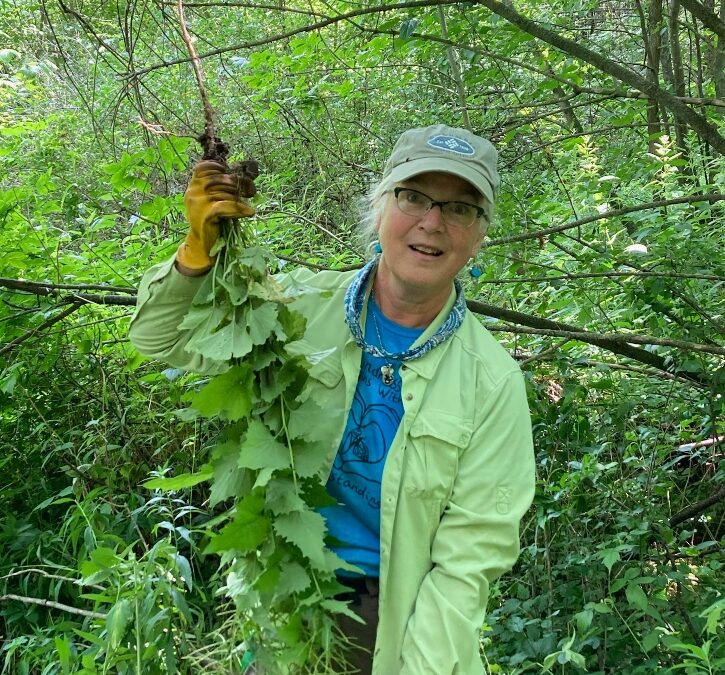When we started our rural adventure, the idea of managing a 7-acre woodland was so exciting. When the reality set in and the task list grew, it brought me angst, fear and dread. My hopeful optimism of moving beyond all of those emotions was realized about three years later with help from the Wisconsin Coverts Project. We got the knowledge, network and resources to appreciate, cultivate and care for our woods.
First task for maintaining the forest diversity is invasive species eradication.
#1 invasive is garlic mustard…
 It is prolific, stealthy, and damaging to the beneficial soil fungi, making the habitat less welcoming to native plants. See photo of dense garlic mustard plants (Photo Credit: WI Woodland Owners Association). That put me in attack mode. Here are some lessons I have learned from our years-long effort to control it.
It is prolific, stealthy, and damaging to the beneficial soil fungi, making the habitat less welcoming to native plants. See photo of dense garlic mustard plants (Photo Credit: WI Woodland Owners Association). That put me in attack mode. Here are some lessons I have learned from our years-long effort to control it.
- Don’t be fooled by the attractive appearance of the first-year seedlings, tiny oval leaf doublets. (“What a sweet little ground cover!” was my first thought…NOT!!!). Scuff the tender plants when you find them.
- Get it early when you see only one or two plants. One plant produces hundreds of offspring!
- When you find a patch, start at the periphery with a search for satellite plants, then work inward.
- Don’t skip a summer of pulling! It set me back more than one year when I skipped.
- Pull it out from the base of the plant, not the stalk. Two reasons: 1) my helper holds a single plant with 15 stalks 2) the roots do almost right angles and break easily. A new plant will grow from remaining root.


Mechanical control, not chemical…
Over the past 4 years, I have experimented with Round-Up (no more!) and Crossbow. Neither worked. Full crop the next year in the same locale. My first thought was possibly latent seeds that just sprouted. But when I started pulling them up, the roots were mature, likely a failed kill by chemicals.
The Wisconsin Woodland Owners Association has excellent guidance for garlic mustard control. Early Spring, pull low plants and leave them to decompose. Early Summer, mow (or weed whack) them down a couple of times, but check every few weeks for new sprouts. I had about 80% successful kill of plants with mowing. Click to see the table. Once flowers show up, pull plants, detach flowers for compost in garbage cans. Once seed pods form, pull plants, detach pods for compost in garbage cans, detach root from stems.
Edible? Yes, with caution!
See my instagram post. Apparently folks do eat it, but our experience guided us to keep it in the garbage can. Among other cautions, beware of cyanide.
What’s the gain in trying to eradicate Garlic Mustard?
Our appreciation for the woods – its beauty, its diversity, its peacefulness – has grown. I LOVE MY WOODS. This summer has been the best! Between three of us (two fantastic teenagers and me), we have put in between 8 and 12 hours a week since late May. Third week of July, we were all together on the afternoon in which we stopped early… because we could not find another tall garlic mustard plant. “Wait! Did we finish???” Seems that way, at least for the worrisome tall plants with seed pods!
Instead, we see an immense diversity of ground plants.
With each year, we see less garlic mustard, and more plants and animals finding a home in our woods.
Photos by SAM and Bob Steiner


